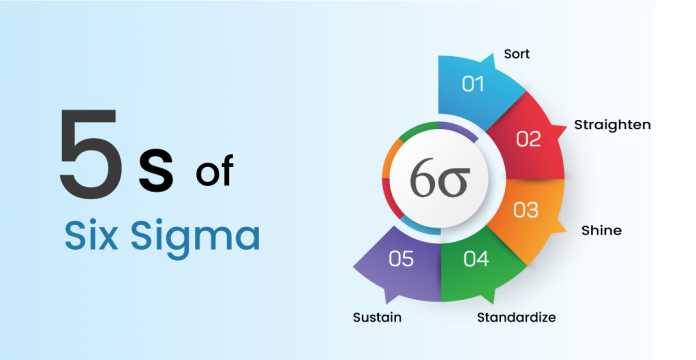
What is 5S Method in Six Sigma?
5s will change your life and your organization. Many people assume that “5s is just about being clean and being organized”, “it was created for the neat freaks.” But it wasn’t actually. 5s was created to solve a problem. We all live in the same world with universal law called entropy or the second law of thermodynamics. It has more to do with heat engines, but we still experience something just like it in everyday life. It says that everything in the universe moves from a state of order to disorder, from clean to dirty, from new to old, or however you want to call it. If you’re running a business, you should be doing something about it. The thing is that 5s goes deeper than just being clean and organized.
- You cannot be efficient.
You cannot be efficient when your environment would be messy and disorganized. How can you be productive in being inefficient like that?
- You cannot detect abnormalities.
You cannot detect abnormalities and problems when your environment is so cluttered and disorganized. You can’t tell what’s right, what’s wrong, what’s on schedule, what’s behind schedule, where something belongs, where do you find something, is it where it belongs. You can’t know that at a glance without solving this problem of entropy. You can’t detect problems.
So, 5s was created to do these two things: to solve the issue of efficiency and solve the problem of not detecting when things are different from standard.
What is the purpose of 5s in the workplace?
5S is designed to minimize waste while maximizing efficiency by maintaining an organized workspace and using visual cues to produce more consistent operating performance. Smart businesses are fueling growth through lean operations in today’s competitive environment. Implementing lean practices, which concentrate on waste disposal in the industry, generates cost savings while maintaining a continuous improvement environment. It is the right way for businesses to familiarise themselves with continual cycles of change by engaging employees in coordinating and enhancing workplace conditions.
What are the 5s principles?
5S is a way of arranging a workspace to make it secure, productive, and efficient. 5S aims to create a clean, uncluttered environment that enables individuals to do their jobs without wasting time while reducing the risk of injury as well. It is intended to assist in creating a physically and mentally quality work environment. The 5S quality tool comes from five Japanese words, starting with the letter ‘S,’ which provides a place for visual inspection and lean manufacture. 5S originated in Japan and has proved to be one of the world’s most valuable Six Sigma methods as it does an adequate job of eliminating waste in a process.
The following Japanese words are translated into the 5S version of the English language.
| Japanese | English |
| Seiri | sort |
| Seiton | set in order |
| Seiso | shine |
| Seiketsu | standardize |
| Shitsuke | sustain |
| Step | Definition | Principles | Example |
| Sort | Eliminate something unnecessary by separating the required tools, parts, and instructions. | Review tools, parts, instructionsKeep only what is essentialEliminate anything non-essential | Obsolete/expired proceduresDamaged/expired inventoryDefunct/old equipment |
| Set in order | Organize whatever remains by grouping and labeling components and tools neatly for ease of use. | Arrange items in a logical orderIndicate places for each item clearlyKeep every item near where it is used | Excess movementExcess transportationOver ProcessingOverproductionExcess inventoryExcess delaysDefects |
| Shine | Clean up the work environment by conducting a cleanup campaign. | Make cleaning a part of daily workAssign areas of responsibilitySend all items or files to their assigned location | Dirty tools & equipmentSpills & leaksClutter & mess |
| Standardize | Schedule daily cleaning and maintenance of seri, seiton and seso every day. | Establish Type, Order, and Shine standardsMake Standards easy to understand with Visual ControlsAssign and educate on individual responsibilities | Work instructionsHazard WarningsEquipment/tool labelsProcess diagrams |
| Sustain | Developing the habit of always observing the first four S’s makes 5S a way of life. | Measure and monitor the processTackle root causes and prevent reversion to the “old ways.”Promote individual feedback and response for improvements | Emphasize cooperationCommunicate clearlySupport innovation |
Where Can I Apply 5s?
A 5S can be applied to any working environment. It may be a hospital supply/store, a telecom company repair vehicle, a CSR desk/work area in a call center, an airline luggage allowance area. 5S is seen as a foundational aspect of the Toyota system because it is difficult to produce consistently successful results unless the workplace is in a clean, structured state. A messy, cluttered room can lead to errors, production slowdowns, and even accidents, all of which disrupt operations and harm a company.
How Is 5s Methodology Implemented?
Seiri Or Sort
Sorting through workplace content and redundant objects are excluded. This step ensures that all unwanted items are found and eliminated from the working place.
For any item in the workplace, we must ask the following three questions:
- Is there a need for this element?
- Do you need this amount if necessary?
- Does it need to be located here, if necessary?
Once these elements are identified, then we take action through:
- Hold them for a while in a red tag area to see if they are needed
- Throwing or discarding them away
- Modifying their place
- Leaving the same location for them
Seiton Or Set In Order
Putting the necessary items in their place and giving them easy access. This step attempts to place every essential item in good order and focus on reliable and efficient storage methods. When implementing Seiton, ensure that these three steps are followed:
Step 1: Determining suitable locations.
Step 2: Identifying the locations.
Step 3: Identifying all products and the amount required for them.
Seiso Or Shine
It includes cleaning everything, keeping it clean every day, and cleaning to search for defects in the workplace and equipment. This step is an attempt to clean the workplace regularly. In 5 steps, we can enforce the third S:
Step 1:To decide what we’re going to clean.
Step 2:Dividing the workplace into “cleaning zones” and then appointing persons responsible for those particular areas.
Step 3:Determining strategies for cleaning: what, where, who, when, and how.
Step 4:Put the cleaning equipment to store them in locations where they can quickly locate, use, and return.
Step 5:The final move is to implement systematic inspection for cleaning.
Seiketsu Or Standardize
It requires visual controls and guidelines to keep the workplace organized, clean, and orderly. This step states that it ensures a high level of good housekeeping. The first three steps, or S’s, are often done by order. Seiketsu helps to transform it into standard, natural behavior. When implementing Seiketsu, make sure that you obey these three steps:
- Decide who is responsible for establishing the appropriate conditions for the maintenance of the first 3S.
- By incorporating everyday care, stop setbacks.
- Check the maintenance standard.
All should be able to differentiate at a glance between normal and abnormal circumstances. If the same thing happens again and again, it’s time to go to the next level: prevention and root cause analysis:
- Why are we collecting unnecessary items? (The Preventive Organization)
- Why don’t tools and things go back to the right place? (Preventive Order)
- Why are the floors getting dirty again and again? (Preventive cleaning)
Shitsuke Or Sustain
It involves training and discipline to ensure that everybody complies with the 5S principles. This step is a state where all participants practice the first four S’s spontaneously and voluntarily as a way of life. It thus becomes the culture of the company.
Conclusion
Five S Technique allows the workplace to eliminate objects that are no longer required (sort), to arrange items to maximize productivity and flow (straighten), to clean the environment to more easily recognize issues (shine), to enforce color coding and labels to remain consistent with other areas (standardize), and to establish habits that keep the workplace organized over the long term (sustain).
Learning various Lean/Six Sigma tools and techniques requires training and for some companies they need certain individuals in the hierarchy to be certified in popular Six Sigma Certifications and Quality Management Courses. If companies want to stay competitive in this complex business landscape, then it is critical that individuals and enterprise teams are trained accordingly to meet market demands.
Some of the popular quality management training courses that individuals and enterprise teams can take up are:
















